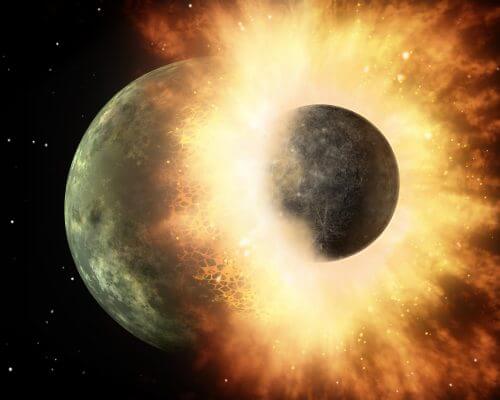According to a new study by scientists from the Weizmann Institute, the moon may have been formed as a result of several collisions of celestial bodies with the earth. This, in contrast to the theory that has prevailed until now, which believed that it was one significant event that caused its formation.

Many studies designed to unravel the mystery of the formation of the moon that orbits the earth led to the development of a theory that holds that a significant event, one and only, gave birth to the moon. This is an event in which a celestial object, the size of the planet Mars, violently collided with the young Earth. This collision caused a large cloud of material, earth and rocks, to rise into orbit around the planet, and that material condensed and crystallized into one mass - the moon.
hall, New research which was recently carried out at the Weizmann Institute of Science, and within the framework of which hundreds of complex computer simulations were carried out, suggested that it is more likely that the moon was formed as a result of several collisions of smaller celestial bodies with the earth. Each such collision led to the formation of a "moon", so that over time a number of small moons were formed, which later, as a result of the development of their peripheral movement around the Earth, and due to the force of gravity, coalesced and together formed the moon we know today. The study was published today in the journal Nature Geoscience.

Research student Raluka Rufo andProf. Oded Aharonson, from the Department of Earth and Planetary Sciences at the Weizmann Institute of Science, say that the accepted explanations for the formation of our Moon are based on the existence of unique and defined initial conditions: a collision of the Earth with a celestial body of a certain size, moving at a certain speed, and hitting the planet at a certain angle . The chances that all these conditions will be met at the same time are not great. In fact, following such an impact, parts of the material of the foreign body that hit the Earth would have remained, both on the Earth and on the Moon. But examination of soil and rock samples brought from the moon showed that chemically it is almost identical to the Earth. That is, no signs of material originating from an alien celestial body were found. Prof. Aharonson explains: "If the moon was formed as a result of the collision of a single, large foreign body, it is reasonable to assume that at least part of the material of the 'foreign' body would have remained, both on the moon and on the Earth. If this were the case, we would find substances with different chemical signatures in both, for example, different quantitative ratios between the isotopes ("versions") of oxygen (oxygen 16, 17, and 18). But in practice we find that the chemical-isotopic signature of the moon is the same - with a very high level of accuracy - as that of the Earth."
Rufo and Prof. Aharonson, along with Dr. Hagai Peretz from the Technion, therefore wondered if a series of collisions of smaller bodies might better explain what happened billions of years ago, when the solar system was formed. Such small bodies were then common in the system, so the chances of them colliding with a planet seem relatively high. Smaller high-speed collisions could also have removed a larger amount of material from the Earth, compared to the amount of material that could be removed by a single collision of a larger body. The scientists believe that collisions with relatively small objects, whose size is about one-tenth to one-hundredth the size of the Earth, sent clouds of dust, sand, rock fragments, molten material and steam into orbit around the planet. These materials, after cooling, formed a number of small moons, which later coalesced and together formed the moon we know today.
But what are the chances that this is what really happened? To test this, the scientists ran about 800 collision simulations on the Chemfarm computer cluster of the Weizmann Institute of Science, where more than 5,000 processors operate simultaneously. "The scenario according to which a number of small bodies collided with the Earth," Rufo says, "does not require the existence of defined conditions. And if the tiny moons that were created in this way were to reach the same peripheral orbit around the Earth, it is probable that over the course of millions of years they would merge and together form a moon the size of our moon." Now the scientists are performing additional simulations, to examine the ways in which the small moons that were formed could have merged and together created the moon, which is, among other things, one of the symbols of romance in human culture.
#Science_Numbers
It is possible that the moon was formed as a result of about 12 collisions with the earth - collisions that produced several "moons" until they merged into the moon.

3 תגובות
Makes perfect sense. We have already seen in the impact of the comet Shumkar Levi 9 on the planet Jupiter that it was carried out in more than ten parts. This comet broke up in its orbit in previous orbits near Jupiter and only then hit Jupiter.. This may be what happened here with our small moon in a collision of a larger magnitude,
Thanks to Luka Ruffo and Professor Oded Aharonson for an interesting idea
Sabdarmish Yehuda
Excellent